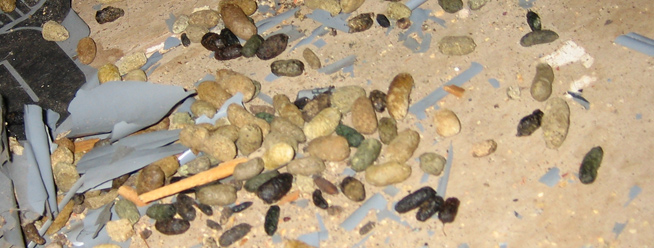If you have finding small black / brown pellets around your home, around 3/8 of an inch long, and about 1/8 of an inch in diameter, there's a good chance you have a rat infestation. The more poop you find, the more rats there are, or the longer those rats have been in your home or commercial property. These little pellets, combined with a bit of noise, are often the first giveaway signs that rats have invited themselves into your property, and if you spot them, they are NOT to be ignored. Rats are quite dangerous animals for something so small and seemingly insignificant.

There are even airborne diseases associated with rat droppings, and that's why you should ensure that you are wearing a face mask when you learning up the area, and make sure you have a good inspection around your home too. Not only does the feces bring with it the threat of disease, it also acts as a signal to encourage other rats to come running. Both the feces and urine of the rats contain pheromones, and this is what these rodents use to communicate with each other.
Go back to the Rats in the Attic home page.

Our homes are the ideal places for some unwanted beings like rats. These rodents enter our homes through any hole, pipes or openings, to find food or shelter during the wintertime. But, how do we know if we have a visit from rats?
In the next post, we will show how to identify rat excrement and where to locate it.
How can we recognize rat feces?
When rats move around, they leave their feces all over the place. Even when they feed. For this reason, one of the greatest pieces of evidence of a rat presence in your home is finding excrement. But, many little animals also excrete leaving their remains scattered in spaces of the house. So, how can you be sure it’s a rat you are dealing with?
How to recognize rat feces
In order to identify the feces of these rodents and differentiate them from other small animals, it is necessary to consider certain characteristics. One of them is the shape of their excrement, which is cylindrical, black in color, and its ends are rounded. Their size will be proportional to the size of the rat. Thus, the excrement has a certain resemblance to a grain of rice. Mice have similar droppings but their tips are sharper. This means that if you look closely at the animal's feces, you can even tell the species.
If the feces are fresh or recently defecated, they will look like this:
- Its color is shiny black
- They are elastic when handled
- They're sticky
If, on the contrary, the stools have been excreted at least one day before, they become a dull color and harden. The smell that rats leave behind when they urinate and defecate is strong, similar to ammonia.
Where should you look for the feces?
Another way of knowing that it is rat droppings is that you will find them near the place where you store food. For example, near the pantry, around the kitchen, or in corners and enclosed places, such as storage rooms or closets, which would serve as a burrow.
You can also find the feces along the walls. If you notice excrements smaller than the size of rice and larger quantities, you may be in the presence of a burrow, since young rats do not move far from their nest.
On the other hand, if you want to know if the rats keep infesting your home, you can do a test by removing the feces found and wait the next few days to see if there are any more stools. This will help you to know if it was an accidental entry or if you already have them permanently in your home.
Tips to prevent a rat’s visit to your home
- Keep all spaces clean. Especially where rodents might take shelter, such as sheds, storage rooms, or where leaves and debris accumulate.
- Avoid leaving your food exposed in the kitchen or place objects that serve as shelter.
- Cover all holes inside and outside your home to prevent entry.
- Garbage cans should be tightly closed.
- If there are pets, avoid leaving food in their bowls, this could be a source of food for rats.
Rat feces are the most accurate evidence you can have of their invasion in your home or office.
Stay alert!








